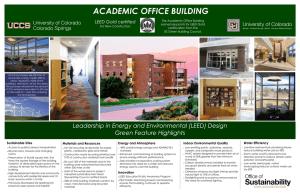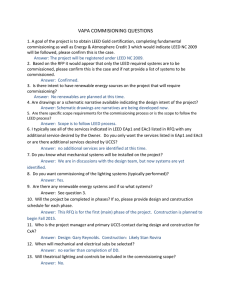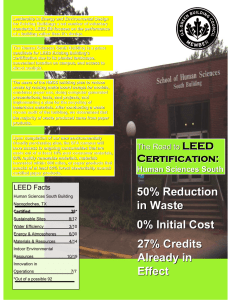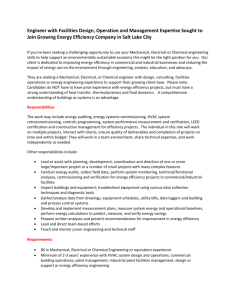Owner`s Project Requirements (OPR) - UF
advertisement
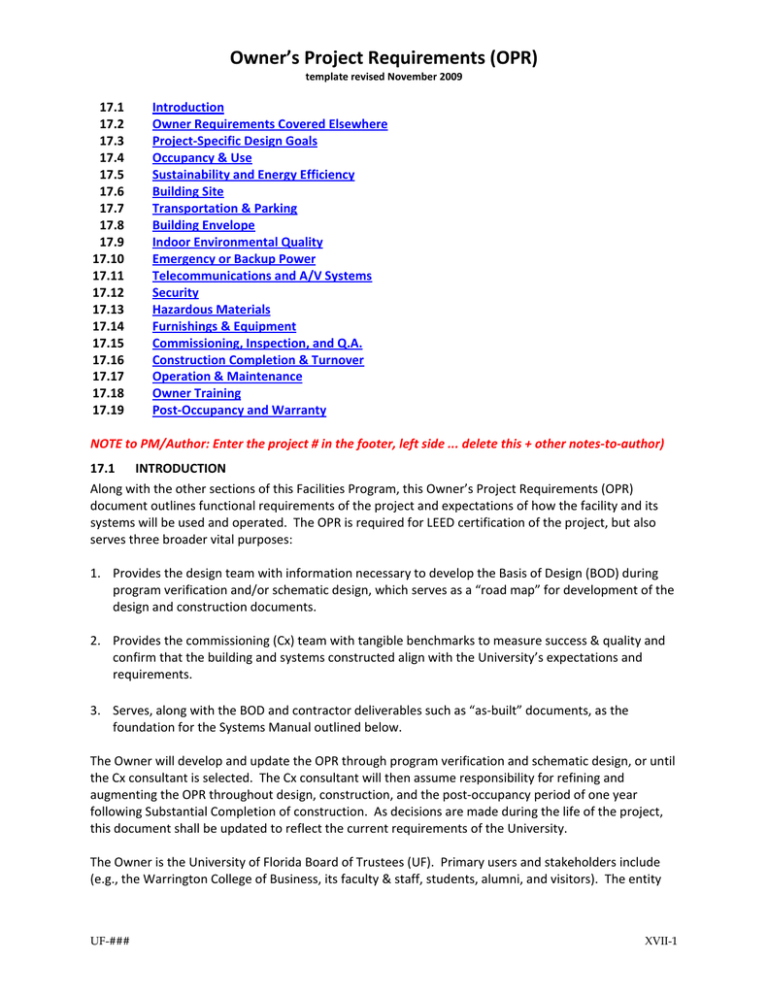
Owner’s Project Requirements (OPR) template revised November 2009 17.1 Introduction 17.2 Owner Requirements Covered Elsewhere 17.3 Project‐Specific Design Goals 17.4 Occupancy & Use 17.5 Sustainability and Energy Efficiency 17.6 Building Site 17.7 Transportation & Parking 17.8 Building Envelope 17.9 Indoor Environmental Quality 17.10 Emergency or Backup Power 17.11 Telecommunications and A/V Systems 17.12 Security 17.13 Hazardous Materials 17.14 Furnishings & Equipment 17.15 Commissioning, Inspection, and Q.A. 17.16 Construction Completion & Turnover 17.17 Operation & Maintenance 17.18 Owner Training 17.19 Post‐Occupancy and Warranty NOTE to PM/Author: Enter the project # in the footer, left side ... delete this + other notes‐to‐author) 17.1 INTRODUCTION Along with the other sections of this Facilities Program, this Owner’s Project Requirements (OPR) document outlines functional requirements of the project and expectations of how the facility and its systems will be used and operated. The OPR is required for LEED certification of the project, but also serves three broader vital purposes: 1. Provides the design team with information necessary to develop the Basis of Design (BOD) during program verification and/or schematic design, which serves as a “road map” for development of the design and construction documents. 2. Provides the commissioning (Cx) team with tangible benchmarks to measure success & quality and confirm that the building and systems constructed align with the University’s expectations and requirements. 3. Serves, along with the BOD and contractor deliverables such as “as‐built” documents, as the foundation for the Systems Manual outlined below. The Owner will develop and update the OPR through program verification and schematic design, or until the Cx consultant is selected. The Cx consultant will then assume responsibility for refining and augmenting the OPR throughout design, construction, and the post‐occupancy period of one year following Substantial Completion of construction. As decisions are made during the life of the project, this document shall be updated to reflect the current requirements of the University. The Owner is the University of Florida Board of Trustees (UF). Primary users and stakeholders include (e.g., the Warrington College of Business, its faculty & staff, students, alumni, and visitors). The entity UF-### XVII-1 Owner’s Project Requirements (OPR) template revised November 2009 responsible for project management and delivery is UF Facilities Planning and Construction (FPC). The organization responsible for operation and maintenance of the facility is the University's Physical Plant Division (PPD). 17.2 OWNER REQUIREMENTS COVERED ELSEWHERE Many components of, or related to, the OPR are covered elsewhere in the Facilities Program, including: Detailed project history, background, and justification – Section IV General planning and design objectives – Section IV Relationship to Campus Master Plan – Section VII Existing site conditions & constraints – Section VIII Project space types, sizes, and adjacencies – Section IX Finishes, M/E/P, telecomm and A/V, and acoustic requirements by space or space type – Section IX Distributed and site underground utilities – Section X Applicable codes – Section XII Project schedule and budget – Sections XIII and XV Additional requirements, expectations, and standards for UF projects are detailed in the following: UF Design & Construction Standards – www.facilities.ufl.edu UF Telecommunications Standards – http://net‐services.ufl.edu/infrastructure/ Design Services Guide – www.facilities.ufl.edu UF Energy Policies, Rates, Provisions – www.ppd.ufl.edu/pdf/UFUtilityPolicy.pdf UF Environmental Health & Safety – www.ehs.ufl.edu 17.3 PROJECT‐SPECIFIC DESIGN GOALS (from Program IV) 1. Flexibility and Future Expansion (example) The administrative suite shall be designed with provisions to accommodate 16 additional staff members over a 10‐15 year period. (example) Interior spaces shall be designed to facilitate reconfiguration as needed to meet changing needs with minimal renovation work, including mechanical, electrical, and telecommunications infrastructure to support expansion of up to 10,000 GSF. 2. Quality and Context (example) The site is at the “front door” of the University. It is imperative that the Hough Hall contextually fits as part of a seamless visual composition, while still establishing its own identity. (example) The College seeks a design that conveys the focus on graduate‐level education with a professional, yet warm, appearance and feel. (example) The building itself will be used as a recruiting tool, and certain spaces will be marketed as naming opportunities to potential donors, so a high level of attention to the performance and esthetics of the facility is warranted. (example) Interior spaces must provide a superior indoor environment to facilitate occupants' comfort and productivity with high indoor air quality, proper acoustics, and no moisture intrusion. 3. Note PM/author: Check with EH&S on the viability or possibility of the facility being used as a storm shelter. If so, elaborate here. 4. (other project‐specific design goal) 5. (other project‐specific design goal) 6. (other project‐specific design goal) UF-### XVII-2 Owner’s Project Requirements (OPR) template revised November 2009 17.4 OCCUPANCY & USE Describe the anticipated hours of operation, occupancy schedule(s), etc. Describe the occupants ‐ number, type, transient vs. permanent, etc. Elaborate on any other special occupancy or usage goals, requirements ... 17.5 SUSTAINABILITY and ENERGY EFFICIENCY As part of an overall commitment to sustainability and a goal of achieving “carbon neutrality” by the year 2025, the University of Florida builds its facilities to last and promotes environmental quality and resource conservation through sustainable design and construction. See www.sustainable.ufl.edu. As part of that commitment and to demonstrate that the facility was designed and constructed to be energy‐efficient and environmentally sustainable, University projects must be certified by the U.S. Green Building Council (USGBC) through its Leadership in Energy and Environmental Design (LEED) process. See www.usgbc.org and www.facilities.ufl.edu/sustain. This project shall achieve LEED‐NC 2009 or EB certification at no lower than Gold level. Specific, high‐ priority goals for this project include: Maximization of the HVAC credits under the Energy and Atmosphere section of the LEED rating system as a first priority. The facility shall operate at a minimum of 28% higher efficiency than ASHRAE Standard 90.1‐2007. The goals for improvement are as follows: 28% 2009 32% 2010 36% 2011 40% 2012 Incorporation of strategies, measures, and systems to conserve energy, such as heat/enthalpy wheels, energy recovery units, “setback” modes, etc. Utilization of the Building Automation System and other controls to efficiently maintain and track performance of key building systems, particularly HVAC and lighting. See UF Design & Construction Standard 15950. Optimization of variable‐flow chilled water systems for maximum building and plant efficiency Use of low‐VOC, regionally‐available, and high recycled content materials. Adoption of "daylight harvesting" to minimize electric lighting usage where functionally practical. Incoporation of solar energy techniques, strategies, and products. Utilization of FSC‐certified wood. (other sustainability/LEED goal) (other sustainability/LEED goal) The Basis of Design (BOD) shall establish specific plans and strategies for achieving these goals, and the construction documents shall include requirements for LEED submittals and sustainable construction practices and techniques, including: Segregated collection and recycling of construction waste UF-### XVII-3 Owner’s Project Requirements (OPR) template revised November 2009 Proper erosion and sedimentation control techniques Procurement and use of low‐VOC, regionally‐available, and high recycled content materials The BOD shall also address the USGBC document entitled “Required Treatment of District Thermal Energy in LEED‐NC” (5/22/08) and its applicability to LEED certification of this project. NOTE to PM/Author: Develop an initial LEED matrix with the FPC LEED Coordinator) The enclosed LEED matrix provides the University’s pre‐design estimate of the probability of securing each credit – high, medium, or low. During program verification and/or conceptual schematic design, the project team will review and update this spreadsheet in order to firmly establish sustainability goals for the project. The matrix will be continuously maintained by the University throughout design and construction as a guideline for achieving LEED certification and tracking progress and action items. Progress Energy – the University’s primary electric and steam provider – has established a rebate program for certain components of new construction that meet energy efficiency requirements, including: compressed air system lighting high efficient chillers motors occupancy sensors energy recovery ventilation thermal energy storage solar, green, or cool roofs demand control ventilation To verify compliance and confirm which rebates apply to this project, Progress Energy will review the 100% Construction Documents and final energy model and will inspect the building at completion. Specific portions of the final MEP drawings/schedules, energy model, and other information will be used by Progress Energy to perform calculations necessary to determine the rebate for each project. The University expects all components of this project/building to be the most efficient and highest quality systems in order to qualify for these rebates. 17.6 BUILDING SITE Elaborate as needed on specific goals or requirements related to the site that aren't covered elsewhere in the facilities program For off‐campus projects, address stormwater/WMD permitting requirements and master plan compliance issues (if any) 17.7 TRANSPORTATION & PARKING Explain available modes of transportation for building users and visitors (auto, bus, bicycle, pedestrian), distinguishing between existing to remain and those to be provided (or removed) as part of the project Define sustainable/LEED parking goals, such as number of spaces dedicated to alternative fuels vehicles, if any UF-### XVII-4 Owner’s Project Requirements (OPR) template revised November 2009 17.8 BUILDING ENVELOPE The exterior shall be designed to endure for at least 75 years. Selection of materials and detailing of envelope systems shall be consistent with the Florida Building Code and UF Design & Construction Standards; performance‐based to allow the building to withstand weather conditions typical of North Central Florida; and esthetically consistent with the area of campus where the facility will be constructed. Prevention of moisture intrusion is a high‐priority goal applicable to all project team disciplines. Solar transmission shall be controlled and designed in accordance with ASHRAE Standard 90.1‐2004 through high‐performance, low‐e glazing, overhangs and external shading, and other techniques to minimize solar heat gain and maximize light transmittance for daylighting where functionally practical. Spaces in this building where daylighting is not functionally practical include: (space type) (space type) (space type) Roofs – anticipated to be flat, modified bitumen; pitched clay tile; standing seam metal; shingle – shall have a minimum reflectivity of 0.30 to reduce solar heat gain. 17.9 INDOOR ENVIRONMENTAL QUALITY 1. Indoor Lighting and Lighting Controls list any non‐standard requirements for illumination, fixtures, lamps, controls, etc. 2. Thermal Comfort Building temperature set points should be established as 74oF – 76oF for Summer and 72oF – 74oF for Winter. PM/Author: Confirm these set points with PPD or other maintenance entity. list any non‐standard requirements for temperature, humidity, controls, etc. 3. Ventilation and Filtration for lab/research facilities, note EHS programs and standards for lab and bio safety, chemical hygiene, etc. list other project‐specific requirements, if known ... e.g., exhaust for lab facilities 4. Acoustics list special acoustic requirements, noting noise criteria (NC) or sound transmission coefficients (STC), if known 5. Other Owner Requirements Elaborate on other miscellaneous or special requirements, such as: Daylighting and views Vivarium requirements Infectious disease control Biosafety level (BSL) Vibration criteria UF-### XVII-5 Owner’s Project Requirements (OPR) template revised November 2009 Electromagnetic Interference (EMI) or Radio Frequency Interference (RFI) stipulations Radiation shielding Pre and post‐occupancy IEQ/IAQ tests will be performed by UF Environmental Health & Safety (EH&S). 17.10 EMERGENCY, BACKUP, or ‘CLEAN’ POWER Explain such requirements if applicable or state "N/A" If such requirements exist, note that chilled water‐fed HVAC may not be reliable and elaborate on emergent cooling & ventilation requirements 17.11 TELECOMMUNICATIONS and AUDIO/VISUAL SYSTEMS Wireless access shall be provided throughout the building and at any defined outdoor gathering spaces. Elaborate on other project‐specific requirements for telecomm and A/V ... Also see section XI of this facilities program. 17.12 SECURITY Elaborate on project‐specific requirements for access control, CCTV, and other security provisions ... 17.13 HAZARDOUS MATERIALS 1. Existing Outline knowns or unknowns for ACM, lead paint, and other hazardous materials that exist or may exist on site 2. Functional Outline known hazardous materials, chemicals, or procedures to be utilized in the new facility 17.14 FURNISHINGS & EQUIPMENT Outline the types of building furnishings that will be furnished and installed by the contractor Outline the types of building furnishings that will be Owner‐furnished and installed, elaborating as needed on such furniture that must be coordinated with contractor‐installed infrastructure, such as power and data for modular office furniture 17.15 COMMISSIONING, INSPECTION, and QUALITY ASSURANCE The Commissioning (Cx) consultant will be independent of the design and construction teams, will be selected by the Conceptual Schematic, Advanced Schematic, etc. phase, and will be responsible for maintenance of this OPR; peer review of the design and construction documents; development of the project‐specific Cx specification using the University’s template “non‐technical” spec; development of the project‐specific Cx Plan; construction and acceptance phase commissioning and documentation; UF-### XVII-6 Owner’s Project Requirements (OPR) template revised November 2009 development of the facility’s Systems Manual; and post‐occupancy commissioning, testing, and documentation. It is anticipated that the following building systems will be commissioned: Mechanical and HVAC systems Electrical and lighting systems Domestic hot water systems Building envelope systems Renewable energy systems (other system) (other system) The following items of particular interest to the University shall be addressed and verified by the Cx consultant throughout the term of service: 1. Meeting or exceeding “Delta‐T” minimums across cooling coils for campus chilled water 2. Accuracy of utilities metering and integration of same with the Building Automation System (BAS) 3. Measurement & Verification of energy usage, performance, and efficiency Onsite inspection of life safety, code compliance, and ADA‐related items will be conducted by the University’s Division of Environmental Health & Safety (EH&S) and the State Fire Marshal. See www.ehs.ufl.edu for more information. Onsite inspection of systems and components governed by the UF Design & Construction Standards and the UF Telecommunications Standards will be conducted, respectively, by the University's Physical Plant Division (PPD) and Office of Information Technology (OIT). The detailed scope of Cx services shall complement these inspections to eliminate gaps or “double coverage” in field oversight. The facility is / is not anticipated to be a “threshold” building as defined by the FL Building Code. The University will hire a qualified "special inspector" directly or as an additional design service to perform the onsite inspection and oversight services required for such "threshold" facilities. The distributed utilities system employed on the main UF campus may necessitate partial commissioning of the energy plant(s) serving the new facility and/or collection of energy efficiency data from PPD. See the USGBC document entitled “Required Treatment of District Thermal Energy in LEED‐ NC,” dated 5/22/08. 17.16 CONSTRUCTION COMPLETION and TURNOVER Inspection, testing, and commissioning culminates in a declaration of Substantial Completion by UF. This date establishes both the beginning of the warranty period and commencement of operation and maintenance by UF. Details on the closeout of major projects can be found on the FPC website. Move‐in of occupants and their personal belongings will not take place until all Substantial Completion “punchlist” items are completed. Elaborate on other project‐specific closeout, move‐in, and turnover goals, requirements ... UF-### XVII-7 Owner’s Project Requirements (OPR) template revised November 2009 17.17 OPERATION & MAINTENANCE The entity responsible for maintenance and operation of the building and its systems, beginning on the date of Substantial Completion, is Physical Plant Division (PPD). In addition to the Cx Plan, field reports, and test reports, the Cx consultant’s primary deliverable is a Systems Manual as required for LEED E/A Credit 3 (Enhanced Commissioning). This manual provides the University with a single source of information and instructions for proper operation and maintenance of primary building systems. As opposed to equipment‐oriented “O&M manuals,” the Systems Manual is to be systems‐oriented to provide operators with easy access to both narrative and technically detailed reference material, descriptions, diagrams, schedules, and other information on stand‐alone and, particularly, integrated systems. Like the OPR and BOD, the Systems Manual should be a living document. Unlike the OPR and BOD, though, the Systems Manual should evolve throughout the life of the building – complied by the Cx from documentation developed by the owner, design team, contractors, and the Cx process itself, then turned over for perpetual use and upkeep by building operators and future consultants and contractors throughout the building's life. 17.18 OWNER TRAINING Onsite training for the Owner – whether operators/maintainers or users/occupants – shall include a description and overview of systems, not just the components and equipment that comprise each system. Training – which is ideally held in conjunction with commissioning – should include general orientation and reviews of the written O&M instructions, relevant health and safety issues or concerns, operation in all possible modes, preventive maintenance, and common troubleshooting problems & solutions. Building systems that the maintenance entity shall be trained on include: HVAC systems BAS/controls Electrical systems Lighting controls Security systems (other system) (other system) Building systems that the occupants/users shall be trained on include: Lighting controls Audio/Visual (A/V) systems (other system) (other system) Most training shall be completed prior to Substantial Completion, and all sessions shall be videotaped and converted to DVD format for the Owner’s use. UF-### XVII-8 Owner’s Project Requirements (OPR) template revised November 2009 17.19 POST‐OCCUPANCY and WARRANTY The Cx consultant, CM/GC, and all subcontractors whose systems were commissioned shall meet with the Owner’s O&M staff quarterly during the first year after Substantial Completion to offseason test, optimize, and otherwise troubleshoot all commissioned systems. Also, an onsite meeting will be conducted 10‐11 months after Substantial Completion to review performance and quality of the facility with all effected parties – UF occupants & users, O&M staff, the design team, and the contractor and its subcontractors. Elaborate on other project‐specific post‐occupancy requirements ... UF-### XVII-9
